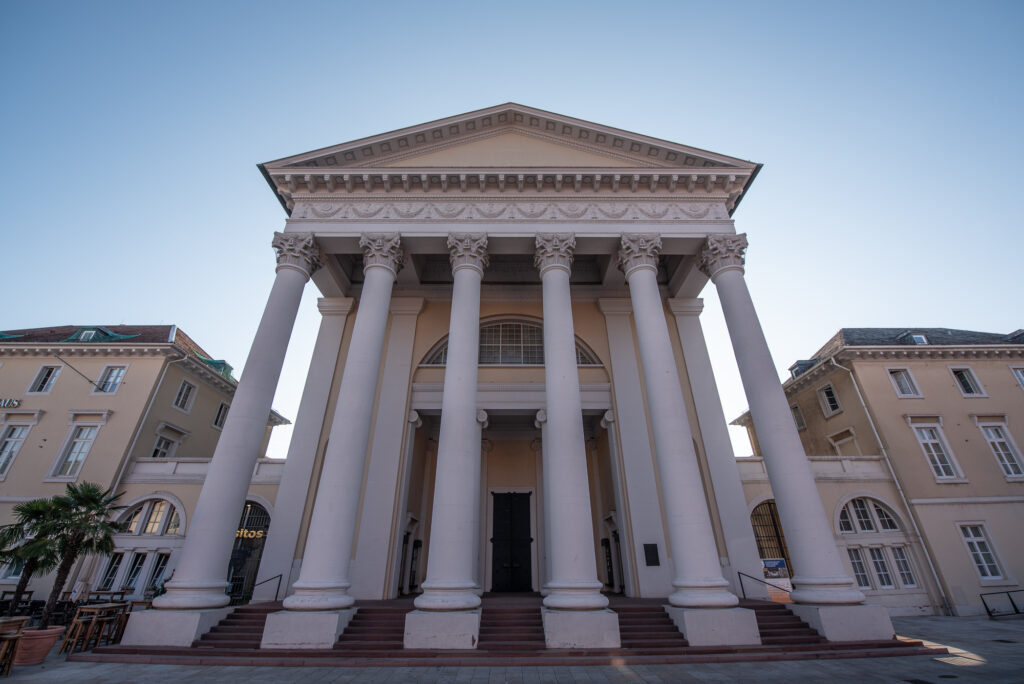Installation in cooperation with Michael Johansson (SWE) in the context of our project Landscape Wandering Machine (link to our blog) and the Ideal Spaces Working Group Foundation (link to the foundation).
Occasion and scope of the project
During the central gathering of the Ecumenicity (World Council of Churches 2022) in Karlsruhe I exhibited as a member of the Ideal Spaces Working Group an art installation which explores the topos of a Heavenly Jersualem from an artistic as well as an aesthetic-historical perspective.
Knowledge can only be iconic, and iconism can only be absolute.
Umberto eco (Travels in Hyperreality, 1983, Page 53)
For picturing an utopian – and therefore an non-imageable – space like the Heavenly Jerusalem motifs such as imagination and the connection between image and conception come into play. A singular Heavenly Jerusalem does not exist, moreover it emerges in each individual subject via the imaginative power, framed by a (symbolic) myth. More on the historical and contextual implications of the project can be found here on the pages of Ideal Spaces Working Group.
Venue
The installation took place from August 28 to September 8 2022 in the central church in Karlsruhe (Evangelische Stadtkirche am Marktplatz).

Although this historic building (planed and built by Friedrich Weinbrenner from 1807 to 1816) has a classicist facade, the building was largely destroyed during the Second World War. The reconstruction in the 1950s opted for the preservation of the architecture on the outside, while the interior was rebuilt in the style of Brutalism.

Concept and Realisation
The characteristic qualities of the brutalistic style made it possible for us to play with the largely unadorned ceiling by using a large scale projection with a professional projector that was able to deliver 30.000 ANSI lumens to an area of around 64m².

Artwork: What is ›Skopéin‹?
Skopéin is an installation that encounters the uptopian place through a symbolic abstraction. In our depiction, the Holy Jerusalem is a purely imaginary product that can be represented exclusively through imaginative affordances. It was very important to us that this installation takes the specific spatial, atmospheric and aesthtic characteristcs of the venue into account. This site-specific animation creates a unique experience for visitors in which animation and its unfoldings become a vehicle for curiosity and imagination. The projection encourages the audience to explore and reflect upon ideas and beliefs about ›what is up there‹. Gravity, imagination, and grace have been a key part of this sequence of images and our exploration of how an upwards motion into a projected space can be designed and experienced.
The animation draws on several historical references, including the film Interstellar, medieval images of heaven, church windows by Gerhard Richter, ornaments, the sound of flapping wings, mountains, valley paintings from the 19th century, as well as the color schemes from the 50s and 60s that are to be found inside the church.
Incorporating all these elements, we set the scene for the animation using procedural mathematics, creating a basic, evolving structure similar to the one found in many sacred buildings. To produce the environments we used a machine of our own making, called The Wandering Machine to design the colour scheme and figurative elements, creating a complex and kaleidoscopic space in which visitors can independently explore and experience their own imagined images of heaven.

Production notes and learnings
Learning: Even a high class projector with this kind of brightness is not powerful enough once the sun hits the church on a sunny afternoon.

Observation: Art inside the church alters the behaviour how people interact inside the sacred space significantly, e.g. during Skopéin it was pefectly OK to lie on the benches for contemplation. I like that a lot: It reminds everybody that a church is a gathering place for everyone.

Learning: A laser distance sensor was a good investment. We did not reconstruct the space in full 3D in order to calculate any necessary distortions and keystone corrections, but knowing the curvature of the ceiling made a lot of things easier.

Learning: Placement of the projector is key and experimentation is always necessary. At first we did some experiments on the 2nd floor of church because the smaller distance between projector and ceiling produced a brighter, more vibrant image. Because of the significant disadvantages (extreme distortion, small image) we changed the placement and exchanged the projector with a mor powerful model. Altough these kind of phenomena could be calculated, on-site experimentation is always neccessary.

Further readings/links
- Report on Skopéin from Kristianstad university (Swedish)
- Video of Skopéin on Michael Johansson’s website
- Short piece about the installation (German)
- Page about the installation on the official website of the World Assembly of Churches
Academic research
Skopéin was featured in the following academic publications:
- Michael Johansson, Andreas Siess (2023): New patterns of prototyping: developing concepts with playful exploration and probing. A case study within arts and design. (Conference paper (double blind peer-reviewed) for: From Abstractness to Concreteness – experiential knowledge and the role of prototypes in design research, International Conference 2023 of the DRS Special Interest Group on Experiential Knowledge (EKSIG). Politecnico di MIlano: S. 66–82. ISBN: 978-8-8941-6743-6)
Link to proceedings (PDF, Open Access, CC BY-NC 4.0)
Download article only (PDF, Open Access, CC BY-NC 4.0) - Andreas Siess, Michael Johansson (2023): Skopéin – Report from the field. In: Urban Eidos Journal (tba)

Comments are closed.